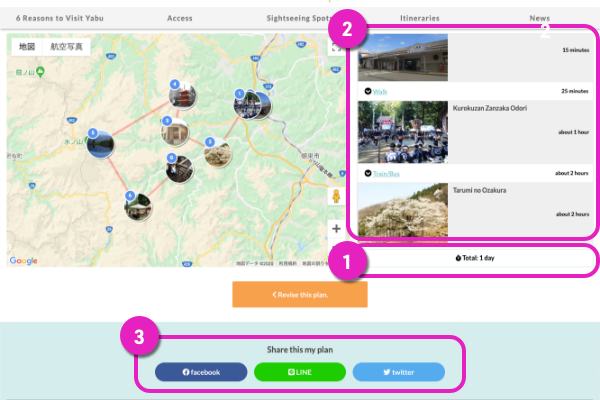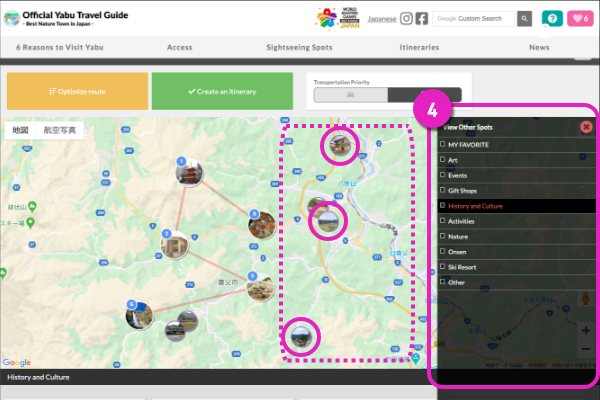How to make your own plan
Step 1
Search for places you want to visit


- Add the spots that you are interested in into ”My Plan” (your favorites)
- This can generate a route automatically by looking at the contents of ”My Plan”.
Step 2
Make a Day Plan!


- Using [My Favorite Spots] , you can put places you want to go into your plans.
- Sort in the most convenient order automatically
- Check the travel route and time by pressing the ”Direction” button (travel route by train, car or on foot will be shown).
- Create route with the ”Create an itinerary” button.
Step 3
Transfer the Plan to your smartphone and head out!

- Show the duration of the route.
- Display the entire route (by foot or by car).
- You can transfer the trip you created to your smartphone or to friends by sharing it on social media or entering your email address and sending it.
As this plan is information that was output to be shared, it will not be deleted even if the original plan is deleted.


- The plans you create will be saved under [My Plans]. Press [Create New Plan] to create a new plan.
- The plan name can be changed using the [Edit] button.
- If you press the [Pin] button, you are able to open the Category menu.
- Add the spots that you are interested in into “My Plan”


Bato Kannon and Signpost

On the cliff is the Bato Kannon (Horse-headed Kannon). This Bato Kannon was enshrined by suppliers using horses in the Edo period. There is also a signpost to Mount Narita with a mei (insciption) from Tenpō 10 (1839).
| Address | 上岩橋萩山909 |
|---|---|
| Tel | 043-496-5334 |
Kōshin Tower of Motosakura

The Koshin Tower was located on the mound of Motosakura South Oshidashi, but was moved to its current location in October of Shōwa 10 (1974) due to the expansion of the Japan National Route 51. As inscribed, it was erected in Kyōhō 10 (1725) when the popularity of the common people's religion rose. Designated as a cultural property by the town.
| Address | 本佐倉字南大堀383 |
|---|---|
| Tel | 043-496-5334 |
Kanakanmuro Ōketsugun

There are seven tombstones in the yokoana cave graves on a steep slope facing west. From one tombstone, Buddhist altar fittings of bronze bowls, chokutō (straight swords) and Sue pottery have been excavated which date back to the period between the late 7th Century to early 8th Century. Legends and known as "Kankanmuro" and "The Hidden Village of Itsukushima Island" have been passed down. Designated as a cultural property by the town.
| Address | 酒々井558-2他 |
|---|---|
| Tel | 043-496-5334 |
Shisui Station Old Pine Tree Monument

This monument is a stone monument erected in commemoration of a giant tree called "Yakakae no Matsu" which died on the October of Meiji 3 (1873). The “Yakakae no Matsu” pine tree is an old pine which was 700-800 years old and is said to have been 33 m tall. Its majestic appearance is depicted on the "Pictures of Noted Places in Narita" and you can think of the past times. The details of Shisuijuku have been engraved on the monument. It is a town designated cultural property.
| Address | 酒々井内方168 |
|---|---|
| Tel | 043-496-5334 |
Oiwake Fudōdōhyō

A large, rare signpost with the carved Seated Statue of Fudo Myoo (Acalanatha) at the top which is 1.7 m tall. The inscription is engraved with the year Enkyō 3 (1746) and is the oldest of those with "Narita Mountain Path" written on them. It became a designated cultural property in Shōwa 46 (1971).
| Address | 上岩橋岩崎286番7 |
|---|---|
| Tel | 043-496-5334 |
Yanagisawa Omago Ryōmakisakaidote

It is a ōdote which became the border between Yanagisawamaki and Omagomaki and was also called the “Umagaeshi no Dote” (embankment a horse cannot travel). This is because during the capturing of wild horses in Omagomaki, the horses chased from the south were blocked by this embankment. By changing the direction and chasing the horses from the southeast, it would drive them to ōgome and tokkome (facilities which captured wild horses). Even now, the name “umagaeshi” has remained as a character name and the traces of maki (pasture) remain today.
| Address | 八街市八街へ199他 |
|---|---|
| Tel | 043-443-1464 |
The Site of Omagomakinoma Tokkome

Omagomaki was established with a tokkome (facility which captured wild horses) when the Yanagisawa-Omagomaki was divided in Kanbun 2 (1662). The dimensions are 95 m north-south, 65 m east-west, and the area is about 5,600 square meters. Currently it is maintained and preserved as a park.
| URL | - |
|---|---|
| Address | 八街市八街へ215-1他 |
| Tel | 043-443-1464 |
Omagomaki Shrine

With the wish to protect horses and the peace of the local residents, it was built by receiving the spirit of the Umagami Shrine in Ōtsu City, Shiga Prefecture. The shrine is surrounded by peanut fields which were once maki (pastures).
| Address | 八街市四木1925-1 |
|---|---|
| Tel | 043-443-1464 |
Benten of Koeppa

A girl who was sold for land tax and suffering from work, fled at night but took the wrong way and could not return to the village. She then threw herself in the pond near the maki (pasture). A villager who felt pity for the girl enshrined Benten (goddess of arts and wisdom) in the pond and comforted her spirit. It is a historical landmark with a folklore showing a part of the lives led by villagers living in Notsukemura.
| Address | 八街市文違77-6 |
|---|---|
| Tel | 043-443-1464 |
Okada Batōkanzeondō

It is said that during the Kamakura period, various disasters fell upon the village after a hakuba (white horse) died on the road. However, after Nichiren comforted the spirit of the hakuba and the statue of Kannon (Goddess of Mercy) in Bunei 1 (1264), the curse subsided. Later, a hall was built to enshrine the statue of Kannon and gathered many nearby followers during the Edo period.
| Address | 八街市岡田120 |
|---|---|
| Tel | 043-443-1464 |
Watanuki Umanosuke

The tombstone of Watanuki Umanosuke who was involved with the operation of the maki (pasture) as a mokushi (a governmental post in charge of maintaining pastures). It is said that he managed a part of the Yanagisawamaki as mochiji (land) and the Watanuki family also attended to the cultivation of the Yanagisawamaki at their private expense.
| Address | 八街市文違297-11 他 |
|---|---|
| Tel | 043-443-1464 |
Konjōin Temple

A temple of the Chizan School of Shingon sect. One of the 53 fudasho of Awa Province. At the Dainichido Hall are the sculptures of “Gohai no Ryū” and ranma (transom) of “Shusen no Zu” made by the sculptor Takeshi Ichirōnobuyoshi when he was 28 years old. Designated as a tangible cultural property of Kamogawa City.
| Address | 鴨川市打墨709 |
|---|---|
| Tel | 04-7092-2043 |
| Fee | free |
